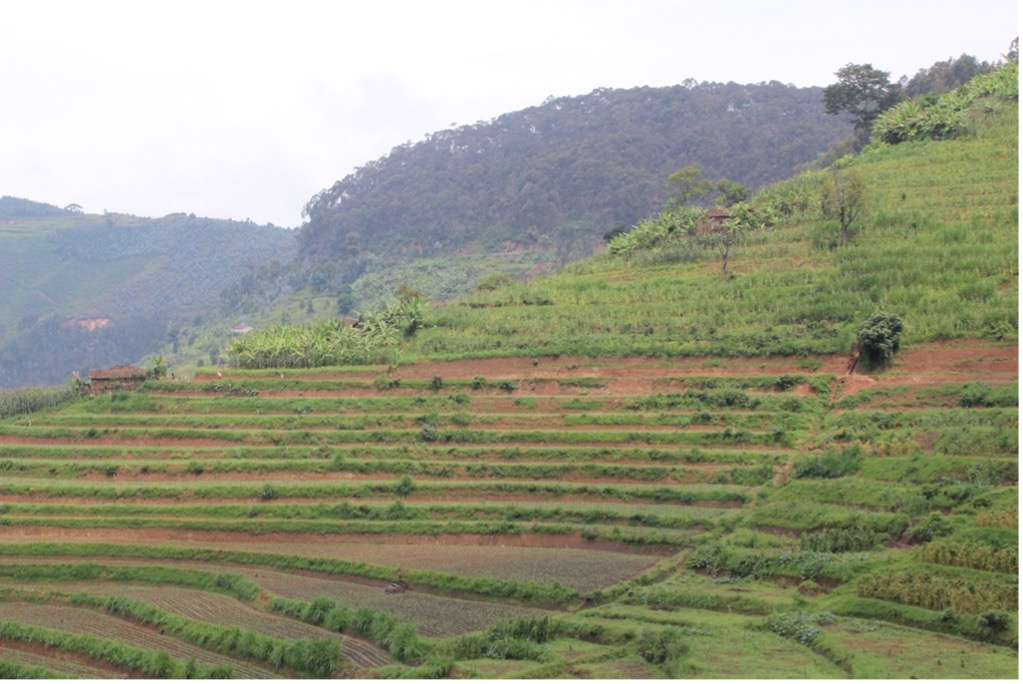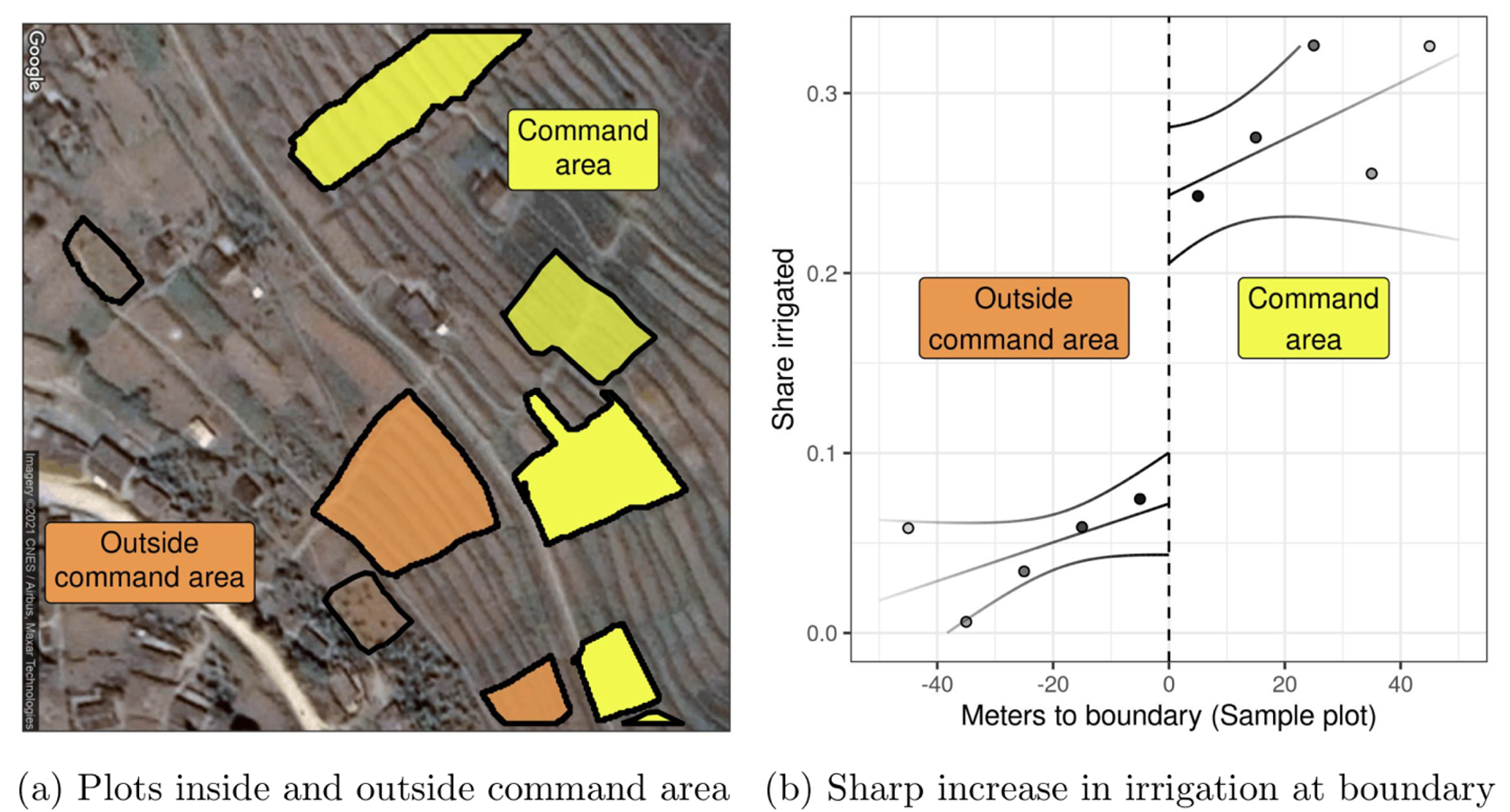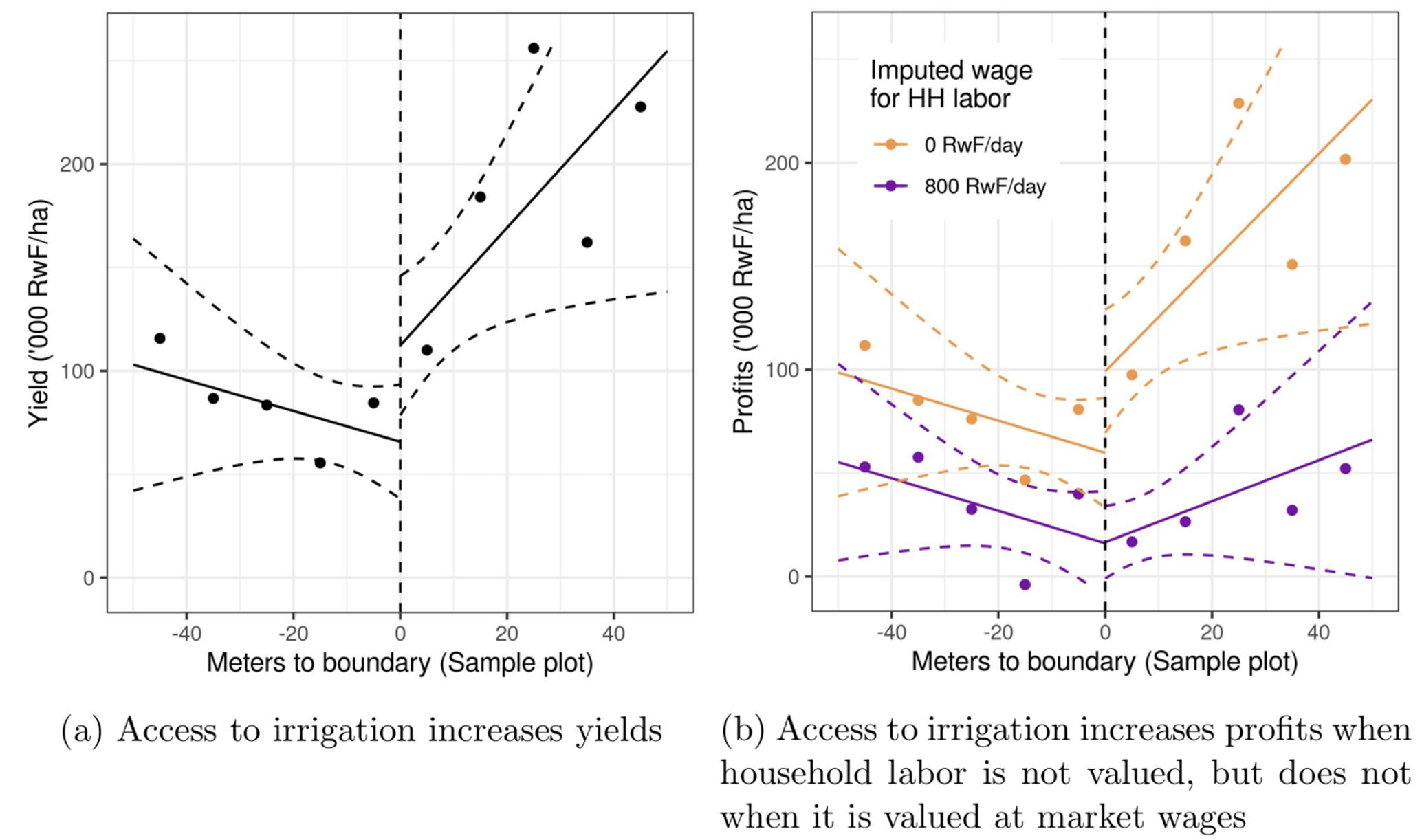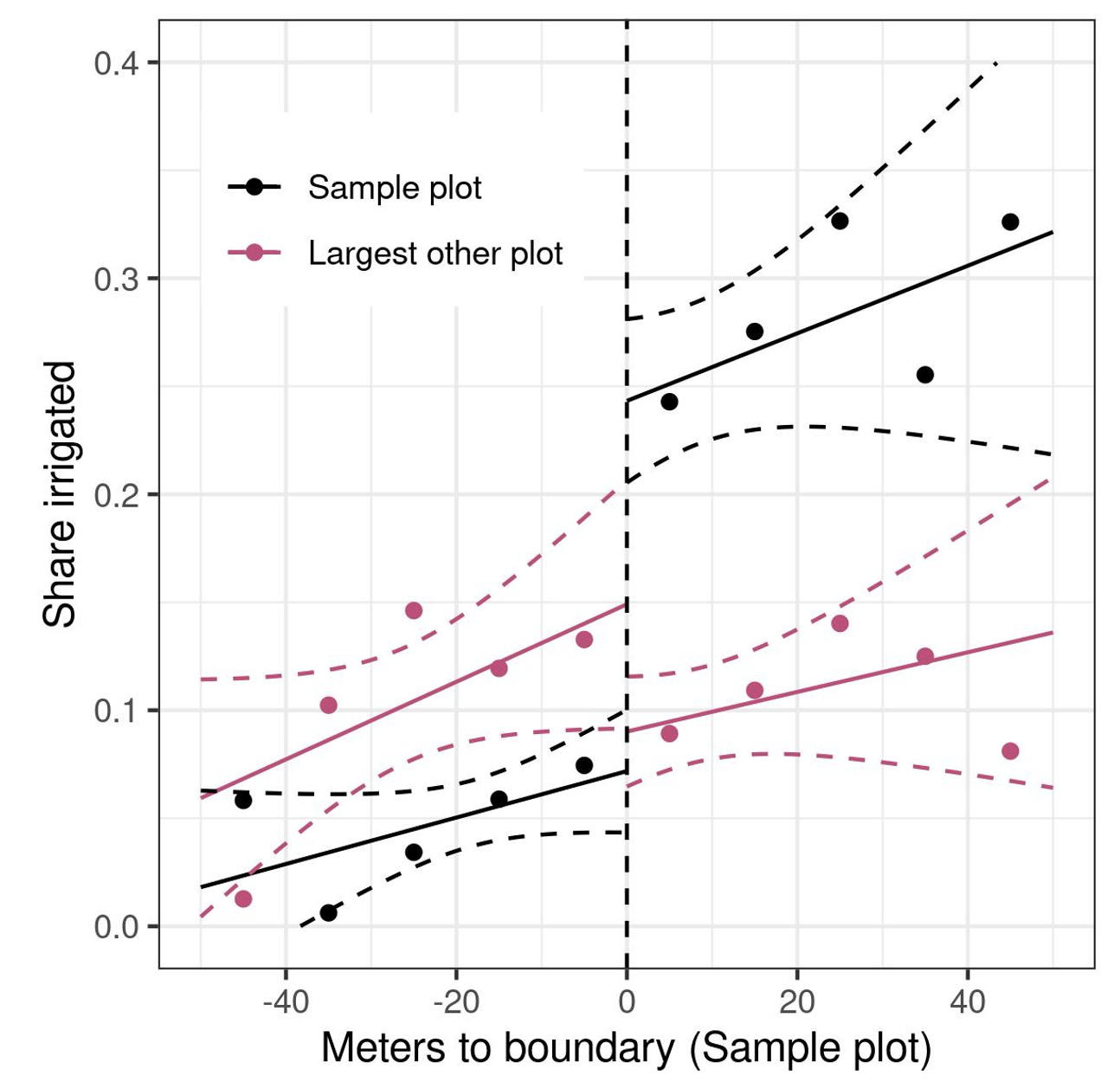
Land and labour market failures lead to inefficient adoption of otherwise promising irrigation technology
A central puzzle in development is the widening gap in agricultural technology between sub-Saharan Africa (SSA) and the rest of the world. Low and slow adoption of proven technologies is often cited as a key force behind this gap. Recent evidence leveraging field experiments shows that imperfect markets for credit, information, and risk (Carter et al. 2019, Emerick and Dar 2022, Casaburi 2018) significantly hinder farming households’ ability to adopt modern technologies. Much less evidence has been produced on the role of land and labour markets in mediating technology adoption. Failures in those markets are likely to be particularly relevant in contexts where technology adoption implies that farmers move from low labour-intensity cultivation to high labour-intensity practices.
Irrigation is a particularly interesting technology to study in the context of SSA, with a vanishingly small share of cultivated land being equipped with irrigation infrastructure across most of the continent (Suri and Udry 2022). This is in sharp contrast with the South Asian context, where irrigation coverage accelerated sharply over the course of the Green Revolution (Gollin et al. 2021). Understanding whether this low coverage of irrigation in SSA due to large differences in returns across farmers (Suri 2011) or to something more structural such as market failures (Udry 1997) is crucial for policymaking.
Figure 1 Hillside irrigation scheme

Note: The figure shows Karoungi 12, one of the hillside irrigation schemes in the study.
In a recent paper (Jones et al. 2022), we show that failures in land and labour markets generate misallocation which limits the adoption of irrigation in Rwanda. We study gravity-fed surface water irrigation schemes: a main canal carries water from a reservoir to the plots, following a slow gradient along the hillside, as shown in Figure 1. While farmers receive irrigation on their plots for free, the sustainability of these schemes can only be ensured if a critical mass of farmers engage in irrigated agriculture and contribute to the operations and maintenance of the schemes. In the Rwandan context we study, irrigation enables the cultivation of horticultural crops (namely onions, tomatoes, carrots, cabbages, and eggplants) in the dry season. These labour-intensive crops can be sold for high revenues at local markets. Without irrigation, farmers either cultivate banana¬ – which has low revenue but low labour demands – or leave their land fallow in the dry season.
Figure 2 Estimating the impact of irrigation by exploiting spatial discontinuity in access

Note: (a) shows the link between our plot maps and the discontinuity. (b) shows how this data relates to the agricultural production data.
Irrigation is productive
First, we test whether this technology is productive in our study context. Gravity generates a discontinuity in access to irrigation: plots just below the main canal receive access to irrigation, while those just above it do not. Because the main canals must conform to prescribed slopes relative to a distant and originally inaccessible water source, the geologic accident of altitude relative to this source determines which plots will and will not receive access to irrigation water. As a result, plots with and without access to irrigation appear similar prior to access to irrigation. We exploit this plot-level discontinuity to formally document the returns to irrigation in Rwanda. We aerially sample 1,700 plots within 50m of the boundary across three sites and interview the households cultivating these ‘sample plots’ over four years.
As shown in Figure 2, the adoption of irrigation jumps discontinuously at the boundary that delimits the command (irrigated) area from the non-irrigated area. Exploiting this discontinuity allows us to provide a causal estimate of the impact of irrigation adoption: annual cash profits increase by 43% - 62%. This effect is fully explained by a transition from low-productivity banana to high-productivity horticulture in the dry season. Access to irrigation does not affect on-farm investment behaviour or productivity in the rainy seasons when rain is typically sufficient to meet water requirements to grow staple crops. Interestingly, our estimate of returns to irrigation is extremely close to the estimate in Duflo and Pande (2007) for India. Irrigation is unusual in SSA, leading to a paucity of evidence on potential returns. While this is just one case study in SSA, our analysis supports the notion that the low incidence of irrigated agriculture in SSA may be the result of other factors instead of just lower returns to irrigation.
Figure 3 Increase in yields as a result of access to irrigation

Note: Large increases in yields occur as a result of access to irrigation, while the profitability of the transition to dry season horticulture enabled by irrigation depends crucially on the shadow wage at which household labour is valued.
Adoption of irrigation is incomplete and constrained
Despite these high returns, we find that only a minority of farmers (30%) adopt this technology, which is provided to them for free. Tracking our study sample over three seasons post-construction does not reveal any significant dynamics of adoption. Even with the large productivity gains accruing to farmers who adopt irrigation, this level of adoption is insufficient to ensure the long-term sustainability of the scheme. If irrigation is a profitable investment, low adoption demands policy action to boost adoption of hillside irrigation.
Before we try to remedy the low adoption of a productive technology, it is important to understand whether this low adoption is in fact constrained or just the result of some farmers experiencing high returns while others do not. We exploit our spatial discontinuity in access to irrigation as a random productive shock that increases demand for inputs on the ‘sample plot’ to produce a test for separation failures — spillovers from constraints faced by a household on one decision that distort unrelated decisions. In our context, if a farmer has two plots and one received, at random, the irrigation shock, that shock should not affect their investment decisions on the other plot: markets should work efficiently to allow farmers to source all the inputs needed to accommodate this higher demand for inputs on one plot without taking away from the other. Instead, when farmers’ investment decisions are constrained by market failures, they would respond to the irrigation shock on the one plot by substituting inputs away from the other plot.
Figure 4 Separation failures

Note: Access to irrigation on the sample plot causes substitution of irrigation use away from the largest other plot
We find that separation fails: as shown in Figure 4, when a farmer’s ‘sample plot’ receives the irrigation shock, they are less likely to be able to use irrigation on their other plot. With finite resources to allocate, farmers must reduce irrigation on other plots to enable irrigation on the sample plot. Market failures constrain irrigation adoption, and adoption is inefficient. We estimate that eliminating this substitution would increase the adoption of irrigation by at least 21%.
Land and labour markets constrain adoption of irrigation
If land markets were frictionless, irrigated land would flow through rentals and sales to the farmers who could cultivate it most productively (in this case, by growing horticulture in the dry season). As a result, the inefficient use of irrigation in these sites suggests the presence of land market frictions. However, theory tells us that frictions must exist in two markets for there to be inefficiency.
Other papers have identified frictions in financial markets and in information as constraints to technology adoption. In our context, which other market frictions are most important? We present three pieces of evidence that labour market frictions constrain adoption of irrigation in our context.
First, we show that how household labour is priced starkly affects estimates of the profitability of adoption of irrigation. When profits are calculated without pricing household labour, the impacts of access to irrigation on profits are almost identical to those we estimate on agricultural production — expenditures on hired labour and inputs on horticulture are small in our context compared to the value of production. In contrast, when household labour is priced at market wages, there is no impact of access to irrigation on profits — horticulture production is highly labour intensive in our context. For smallholder farmers, shadow wages are likely heterogeneous and below market wages (Agness et al. 2022); variation in households’ shadow wage can therefore plausibly drive the profitability of horticulture, and in turn, the adoption of irrigation.
Second, we examine whether wealthier farmers and farmers with larger households are more or less constrained in irrigation adoption. We find that, if anything, wealthier households cultivate their second plot even less intensively in response to irrigation on their first plot. This suggests that frictions related to finance (e.g. credit and risk) are likely not the critical frictions in this context. In contrast, we also find that larger households substitute much less, being able to effectively irrigate two plots. If labour markets function imperfectly, these households will be unable to sell enough labour at market wages leading to more intensive farming on their own plots.
Third, this suggestive evidence is confirmed and extended by a randomised controlled trial (RCT) to test for credit and knowledge constraints: we randomise small seed and fertiliser ‘minikits’ for horticulture. If credit or knowledge constrain adoption, households which did not irrigate in the past should take up the minikits and increase adoption of horticulture. Despite a strong first stage, we find no effects on the adoption of horticulture: take-up was limited to farmers who had used horticulture previously. Between the RCT and heterogeneous effects, we conclude that credit or information constraints do not limit irrigation use. Taken together with our other evidence, we conclude that land and labour market failures are primary constraints to adoption of irrigation in this context.
In summary, we show that land and labour misallocation lead to inefficient adoption of a profitable technology: small households have too much irrigated land, large households have too little. In the specific context of the irrigation sites studied, these frictions pose a threat to the sustainability of this sizeable investment in agricultural productivity. We know little about how to smooth frictions in factor markets – our study emphasises the need for more evidence on role of factor markets in technology adoption and the policy options to improve them.
References
Agness, D, T Baseler, S Chassang, P Dupas and E Snowberg (2022), “Valuing the Time of the Self-Employed”, CEPR Discussion Paper No. 17017.
Carter, M R, R Laajaj and D Yang (2019), “Temporary agricultural input subsidies have lasting impacts: The Mozambique experiment”, VoxDev.org, 21 October.
Casaburi, L (2018), “Protecting insecure farmers”, VoxDev.org, 25 January.
Duflo, E and R Pande (2007), “Dams”, The Quarterly Journal of Economics 122(2): 601-646.
Emerick, K and M Dar (2022), “Demonstrator selection, farmer field days and agricultural technology adoption in India”, VoxDev.org, 9 May.
Gollin, D, C W Hansen and A M Wingender (2021), “When agriculture drives development: Lessons from the Green Revolution”, VoxDev.org, 6 September.
Jones, M, F Kondylis, J Loeser and J Magruder (2022), “Factor market failures and the adoption of irrigation in Rwanda”, American Economic Review 12(7): 2316-1352.
Suri, T (2011), “Selection and Comparative Advantage in Technology Adoption”, Econometrica 79(1): 159-209.
Suri, T and C Udry (2022), “Agricultural Technology in Africa”, Journal of Economic Perspectives 36(1): 33-56.
Udry, C (1996), “Efficiency and Market Structure: Testing for Profit Maximization in African Agriculture”, Department of Economics, Northwestern University.




